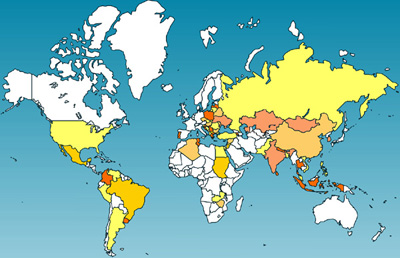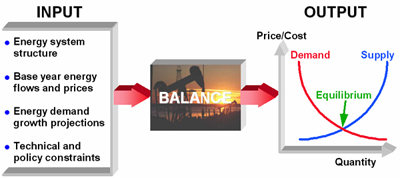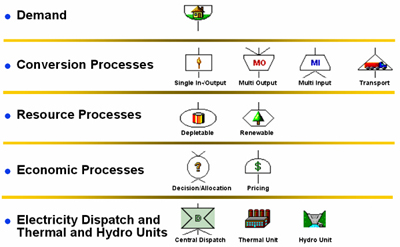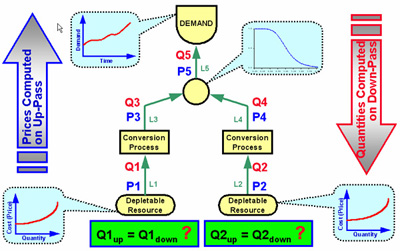Energy and Power Evaluation Program (ENPEP-BALANCE)
The Windows version of the Energy and Power Evaluation Program (ENPEP-BALANCE) is the premier energy systems analysis software in use in over 80 countries. ENPEP-BALANCE has been developed by CEEESA with support from the U.S. Department of
Energy (DOE). ENPEP-BALANCE allows users to evaluate the entire energy system (supply and demand sides) and the environmental implications of different energy strategies. The
latest ENPEP-BALANCE version takes full advantage of the Windows operating environment.
For an overview of ENPEP-BALANCE, click here.
What's New in ENPEP-BALANCE Version 2.20: ENPEP-BALANCE Version 2.20 includes a variety of new features, such as price-elastic demands, fully integrated economic cost calculations, increased maximum number of nodes, new custom reports, enhanced error reporting, improved speed through direct memory allocation, improved database backup routines, added interface features, and more. Click here for more information on the new features in Version 2.20.
- Energy policy analysis
- Energy market projections
- Natural gas market analysis
- Carbon emissions projections
- Projections of criteria pollutants (SO2, NOX, etc.)
- Carbon mitigation studies
Increasingly, model applications focus on climate-change–related issues. ENPEP-BALANCE climate change study reports can be downloaded at various web sites, including the United Nations Framework Convention on Climate Change (UNFCCC) and the U.S. Environmental Protection Agency (EPA).
Click here or click on the map below to see more information about ENPEP-BALANCE applications around the world. In the map, countries with ENPEP-BALANCE applications are highlighted in color.

Distribution of ENPEP-BALANCE: ENPEP-BALANCE is now available to anyone at no-cost. Please contact CEEESA for more information on how to obtain the model.
Overview of ENPEP-BALANCE: ENPEP-BALANCE is a nonlinear equilibrium model that matches the demand for energy with available resources and technologies. Its market-based simulation approach allows
ENPEP-BALANCE to determine the response of various segments of the energy system to changes in energy prices and demand levels. The model relies on a decentralized decision-making process in the energy sector and can be calibrated to the different preferences of energy users and suppliers. Basic input parameters include information on the energy system structure, base-year energy statistics including production, and consumption levels and prices, projected energy demand growth, and any technical and policy constraints.

In this process, an energy network is designed to trace the flow of energy from primary resources to useful energy demands in the end-use sectors.
ENPEP-BALANCE networks are constructed by using different nodes and links that represent various energy system components. Nodes in the network represent depletable and renewable resources, various conversion processes, refineries, thermal and hydro power stations, cogeneration units, boilers and furnaces, marketplace competition, taxes and subsidies, and energy demands. The figure below shows the node types available in
ENPEP-BALANCE. Links connect the nodes and transfer information among nodes.

 ENPEP-BALANCE is very versatile in that the analyst starts with an empty workspace and builds an energy system configuration of nodes and links.
ENPEP-BALANCE’s powerful graphical user interface makes it is as easy as “drag and drop” to build networks of regional, national, or multinational scope. Click on the thumbnail on the left to see a an example of a typical sectoral energy network. The second thumbnail shows a detailed network for an industrial subsector. Drop-down menus can be used to display model inputs and results directly within the energy network. Double-clicking the nodes allows access to more detailed input as well as output information. ENPEP-BALANCE is very versatile in that the analyst starts with an empty workspace and builds an energy system configuration of nodes and links.
ENPEP-BALANCE’s powerful graphical user interface makes it is as easy as “drag and drop” to build networks of regional, national, or multinational scope. Click on the thumbnail on the left to see a an example of a typical sectoral energy network. The second thumbnail shows a detailed network for an industrial subsector. Drop-down menus can be used to display model inputs and results directly within the energy network. Double-clicking the nodes allows access to more detailed input as well as output information.
 The model employs a market share algorithm to estimate the penetration of supply alternatives. The market share of a specific commodity is sensitive to the commodity’s price relative to the price of alternative commodities, as shown in the figure below. User-defined constraints (e.g., capacity limits), government policies (taxes, subsidies, priority for domestic resource over imported resource, etc.), consumer preferences, and the ability of markets to respond to price signals over time (i.e., due to lag times in capital stock turnover) also affect the market share of a commodity. The model employs a market share algorithm to estimate the penetration of supply alternatives. The market share of a specific commodity is sensitive to the commodity’s price relative to the price of alternative commodities, as shown in the figure below. User-defined constraints (e.g., capacity limits), government policies (taxes, subsidies, priority for domestic resource over imported resource, etc.), consumer preferences, and the ability of markets to respond to price signals over time (i.e., due to lag times in capital stock turnover) also affect the market share of a commodity.

Using a market share algorithm distinguishes the equilibrium approach from other modeling techniques. The
ENPEP-BALANCE approach simulates more accurately the more complex market behavior of multiple decision makers that may not be captured by optimization techniques because they assume a single decision maker. Every sector (electric, industrial, residential, etc.) pursues different objectives and may have very different views of what is “optimum.” The equilibrium solution develops an energy system configuration that balances the conflicting demands, objectives, and market forces without optimizing across all sectors of the economy.
ENPEP-BALANCE simultaneously finds the intersection of supply and demand curves for all energy supply forms and all energy uses included in the energy network. Equilibrium is reached when the model finds a set of market clearing prices and quantities that satisfies all relevant equations and inequalities. The model employs the Jacobi iterative technique to find the solution that is within a user-defined convergence tolerance (see figure below).

Concurrently with the energy calculations, the model computes the environmental residuals associated with a given energy system configuration. In addition to greenhouse gases and standard criteria air pollutants (particulates, SOX, NOX, CO, CO2, methane, volatile organic compounds, lead, etc.), these residuals may include waste generation, water pollution, and land use. Greenhouse gas emissions can be reported in a format that is compatible with the Intergovernmental Panel on Climate Change.
ENPEP-BALANCE is used extensively in the global community to conduct greenhouse gas mitigation analyses, energy policy studies, and natural gas market analyses.
Training and Capacity Building: We have extensive expertise and experience because we assist our ENPEP-BALANCE users around the world by providing training and implementation support. Over the last 25+ years, we have conducted training courses in many locations around the world and successfully trained over 1300 experts from
more than 90 countries in the use of our tools. ENPEP-BALANCE is actively in use in many of these countries.
ENPEP-BALANCE training courses and workshops can be tailored to your specific needs and can last from a few days to a couple of weeks. Courses can be held at Argonne's facility in the Chicago area or at your facilities.
Click here for information on past and upcoming training courses or click on the pictures below.
 
Additional Resources: For more information on the model and some of its current applications, download the following brochures, presentations, papers, and reports in pdf format:
The ENPEP-BALANCE model is now available for free to everyone. Please send us an email if you want the latest
version of the software.
For more information about Energy and Power Evaluation Program (ENPEP-BALANCE), contact CEEESA.
|









